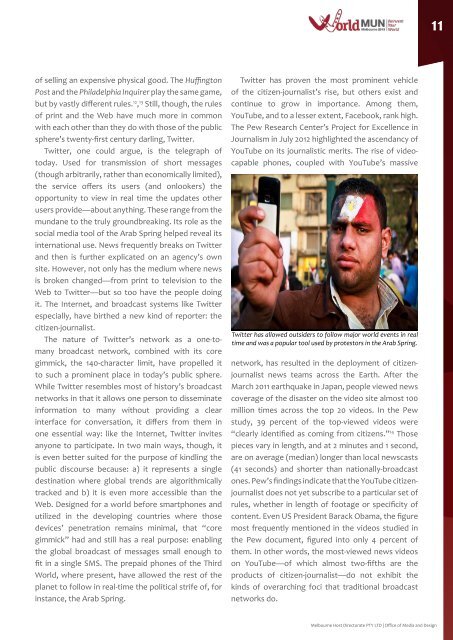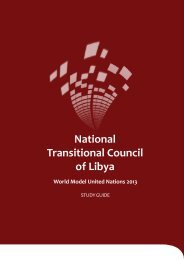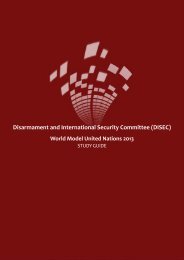Press Corps - World Model United Nations
Press Corps - World Model United Nations
Press Corps - World Model United Nations
Create successful ePaper yourself
Turn your PDF publications into a flip-book with our unique Google optimized e-Paper software.
of selling an expensive physical good. The Huffington<br />
Post and the Philadelphia Inquirer play the same game,<br />
but by vastly different rules. 12 , 13 Still, though, the rules<br />
of print and the Web have much more in common<br />
with each other than they do with those of the public<br />
sphere’s twenty-first century darling, Twitter.<br />
twitter, one could argue, is the telegraph of<br />
today. used for transmission of short messages<br />
(though arbitrarily, rather than economically limited),<br />
the service offers its users (and onlookers) the<br />
opportunity to view in real time the updates other<br />
users provide—about anything. These range from the<br />
mundane to the truly groundbreaking. Its role as the<br />
social media tool of the Arab Spring helped reveal its<br />
international use. News frequently breaks on Twitter<br />
and then is further explicated on an agency’s own<br />
site. However, not only has the medium where news<br />
is broken changed—from print to television to the<br />
Web to Twitter—but so too have the people doing<br />
it. The Internet, and broadcast systems like Twitter<br />
especially, have birthed a new kind of reporter: the<br />
citizen-journalist.<br />
The nature of Twitter’s network as a one-tomany<br />
broadcast network, combined with its core<br />
gimmick, the 140-character limit, have propelled it<br />
to such a prominent place in today’s public sphere.<br />
While Twitter resembles most of history’s broadcast<br />
networks in that it allows one person to disseminate<br />
information to many without providing a clear<br />
interface for conversation, it differs from them in<br />
one essential way: like the Internet, Twitter invites<br />
anyone to participate. in two main ways, though, it<br />
is even better suited for the purpose of kindling the<br />
public discourse because: a) it represents a single<br />
destination where global trends are algorithmically<br />
tracked and b) it is even more accessible than the<br />
Web. Designed for a world before smartphones and<br />
utilized in the developing countries where those<br />
devices’ penetration remains minimal, that “core<br />
gimmick” had and still has a real purpose: enabling<br />
the global broadcast of messages small enough to<br />
fit in a single SMS. The prepaid phones of the Third<br />
<strong>World</strong>, where present, have allowed the rest of the<br />
planet to follow in real-time the political strife of, for<br />
instance, the Arab Spring.<br />
Twitter has proven the most prominent vehicle<br />
of the citizen-journalist’s rise, but others exist and<br />
continue to grow in importance. Among them,<br />
YouTube, and to a lesser extent, Facebook, rank high.<br />
The Pew Research Center’s Project for Excellence in<br />
Journalism in July 2012 highlighted the ascendancy of<br />
YouTube on its journalistic merits. The rise of videocapable<br />
phones, coupled with YouTube’s massive<br />
Twitter has allowed outsiders to follow major world events in real<br />
time and was a popular tool used by protestors in the Arab Spring.<br />
network, has resulted in the deployment of citizenjournalist<br />
news teams across the earth. After the<br />
March 2011 earthquake in Japan, people viewed news<br />
coverage of the disaster on the video site almost 100<br />
million times across the top 20 videos. In the Pew<br />
study, 39 percent of the top-viewed videos were<br />
“clearly identified as coming from citizens.” 14 those<br />
pieces vary in length, and at 2 minutes and 1 second,<br />
are on average (median) longer than local newscasts<br />
(41 seconds) and shorter than nationally-broadcast<br />
ones. Pew’s findings indicate that the YouTube citizenjournalist<br />
does not yet subscribe to a particular set of<br />
rules, whether in length of footage or specificity of<br />
content. Even US President Barack Obama, the figure<br />
most frequently mentioned in the videos studied in<br />
the Pew document, figured into only 4 percent of<br />
them. In other words, the most-viewed news videos<br />
on YouTube—of which almost two-fifths are the<br />
products of citizen-journalist—do not exhibit the<br />
kinds of overarching foci that traditional broadcast<br />
networks do.<br />
11<br />
Melbourne Host Directorate PTY LTD | Office of Media and Design
















